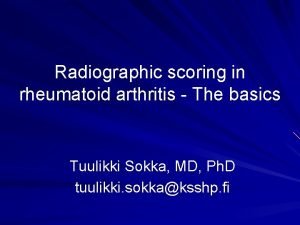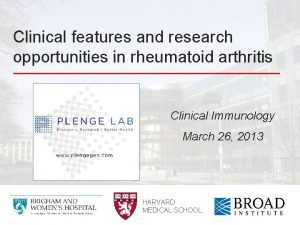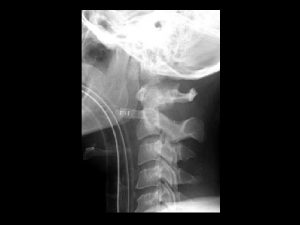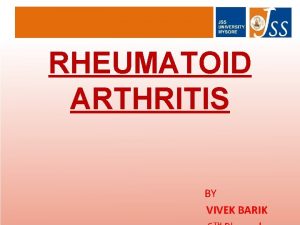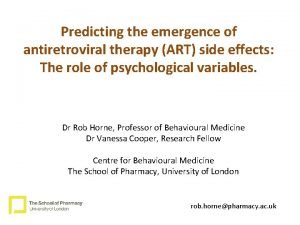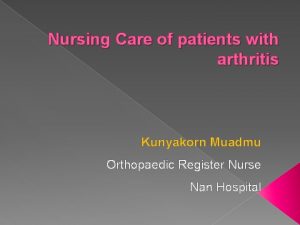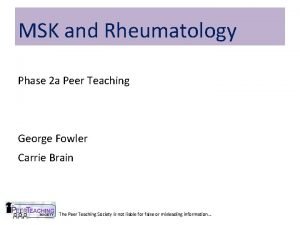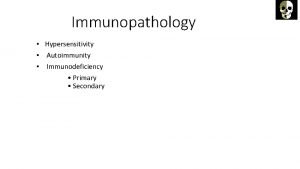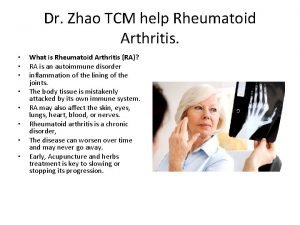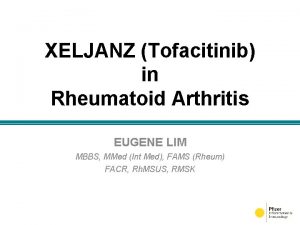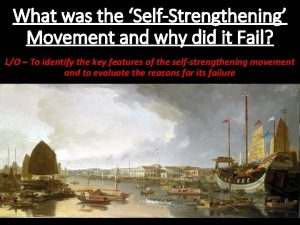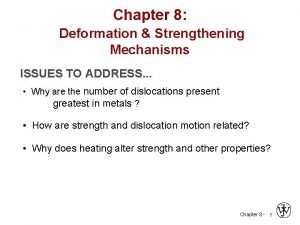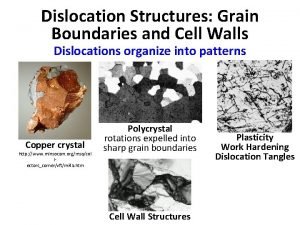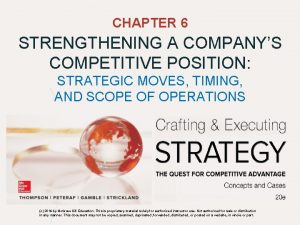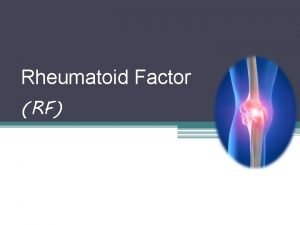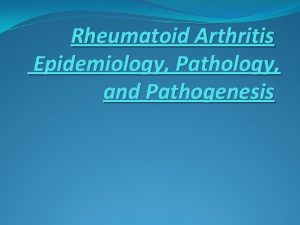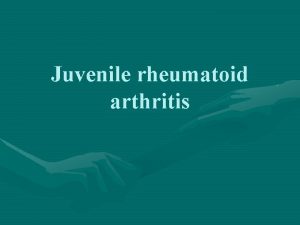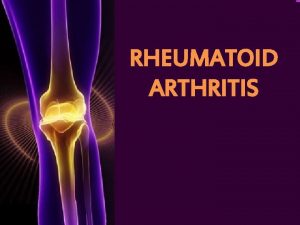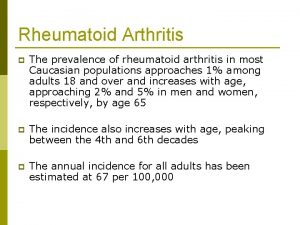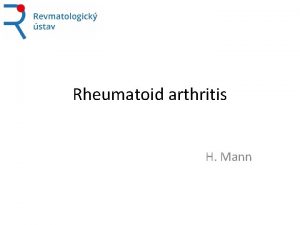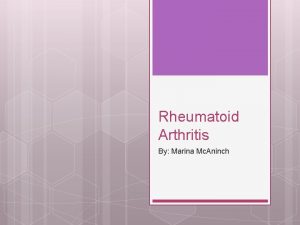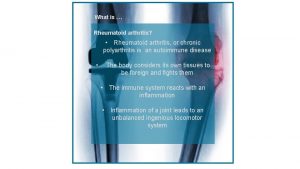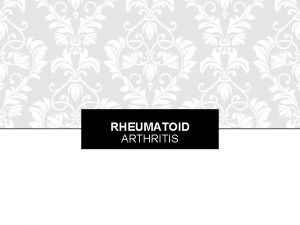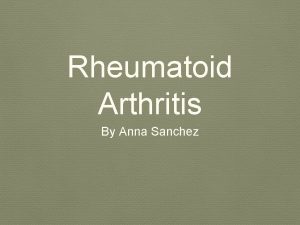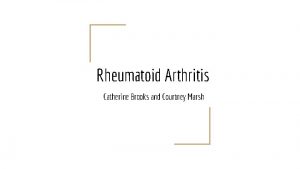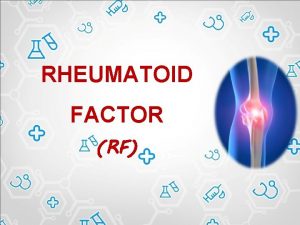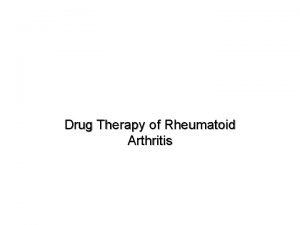SARAH Strengthening and Stretching for Rheumatoid Arthritis Affecting





















- Slides: 21

SARAH: Strengthening and Stretching for Rheumatoid Arthritis Affecting the Hand: A randomised controlled trial Adams J, Williams MA, Heine PJ, Mc. Conkey C, Lord J, Dosanjh S, Williamson EW, Rahman A, Underwood M, Lamb SE on behalf of the SARAH trial team Dr Jo Adams Associate Professor. Professional Lead for Occupational Therapy. Faculty of Health Sciences University of Southampton ja@soton. ac. uk http: //www. southampton. ac. uk/healthsciences/about/staff/jo_adams. page

Background • Wrist and hand joints are affected early in RA (Adams et al 2004; Horsten et al 2010) • Early RA = hand wrist pain, weakness, ↓mobility, stiffness for majority of patients even with medical advances (Weinblatt 2013; Boers et al 2012; Toyama et al 2013; Seto et al 2013)

Background • Functional limitations that impact on work, leisure and quality of life (NICE 2009; Seto et al 2013)

Background • UK Clinical guidelines state that individuals with RA should have access to specialist hand therapy for ex’s to ↑ strength, movement and function (Deighton et al 2009 and Luqmani et al 2009) • Evidence base for specialist hand therapy is weak (Wessel, 2004 and Ottawa Panel, 2004) • National Institute of Health Research HTA funded call into the effectiveness of hand therapy for people with early RA(£ 1 million)

Research Questions 1. What is the clinical effectiveness of adding a therapy programme for hands and upper limbs in addition to, usual care in the reduction of hand dysfunction and pain for patients with RA. 2. What is the cost-effectiveness of adding this programme to usual care.

Study Design RA patients referred to PT/OT from RA clinic Checked for eligibility Research Clinic appointment Blinded Baseline Ax Usual care Intervention (n=240) Joint protection, mobility exercises and functional splinting Individually randomised Exercise Intervention (n=240) Control intervention then 5 additional sessions of optimised exercise programme (12 weeks) Blinded Follow-up assessments at 4 and 12 months

Inclusion Criteria • • INCLUDED • People with RA meeting the ACR clinical and immunological criteria. • Pain and dysfunction of the • hands and/or wrist joints. • Either not on a disease • modifying medication (DMARD), or have been on a • stable DMARD regimen for 3 months or more. • EXCLUDED Patients recovering from upper limb joint surgery, or fracture, in the previous 6 months. Patients on a waiting list for upper limb orthopaedic surgery. Patients who are pregnant. Aged less than 18 years.

Materials and Methods • Usual care intervention • 1 -3 sessions, joint protection education, general exercise advice, ± functional splint • Enhanced tailored functional exercise programme intervention • • Usual care plus 5 additional sessions of supervised functional exercises 7 stretching 4 strengthening Adherence-promoting strategies for daily home exercise programme All delivered by an experienced hand therapist trained in SARAH protocols (n=48)

Materials and Methods

Materials and Methods Implementation Strategies

Materials and Methods

Materials and Methods • 1° outcome – Michigan Hand Outcomes (MHQ) Questionnaire hand function subscale • 2 ° outcomes – MHQ, pain, Qo. L, physical impairments, selfefficacy, Quality Adjusted Life Years (QALY) Intention to treat analysis Health Economics – intervention costs, resource use, EQ-5 D Target fully powered sample to detect a clinically meaningful difference n = 480 • • •

Results • 490 randomised (244 Usual Care, 246 Extended Functional Exercise programme) • Groups well matched at baseline • 75% compliant with treatment • 438 (89%) followed up at 12 months

Baseline Characteristics Usual Care (n=242) Enhanced Functional Exercise (n=246) Age Mean(SD) 63. 5(11) 61. 3 (12) Sex (% Female) 186(76%) 188 (76%) Employment status (n%) Full time 22(9) Part time 30(12) Self employed 10(4) 29(12) 26(11) 11(5) Right/Left Dominance (n%) Right 215(90) Left 23(9) 226(92) 18(7) Years since RA diagnosis (median IQR) 10 (4, 22) 10(4, 21) Baseline biologic DMARD (n%) 52(22) 51(21) MHQ overall and ADL Mean(SD) 52. 1(16. 4) 54. 1(25. 0) 52. 1(15. 2) 54. 5(24. 5) SF-12 Mean(SD) 34. 5(9. 5) 33. 8(9. 8) Grip Ns Mean(SD) 130. 3(73. 1) 134. 2(83. 3)

SARAH Consort Trial Flow Chart Results

Results Outcome Mean Change from baseline Usual / Enhanced (95%CI) Mean Treatment difference P value MHQ Function 4 months 12 months 4. 04(2. 17 to 5. 91)/ 8. 73(6. 83 to 10. 64) 3. 56(1. 45 to 5. 68) / 7. 93(5. 98 to 9. 88) 4. 60(2. 22 to 6. 97) 4. 35(1. 60 to 7. 10) 0. 0002 0. 0020 MHQ ADL 4 months 12 months 2. 57(-0. 40 to 4. 74)/ 7. 86(5. 44 to 10. 28) 2. 27(-0. 04 to 4. 59)/ 5. 89(3. 66 to 8. 13) 5. 46(2. 41 to 8. 51) 3. 78(0. 64 to 6. 93) 0. 0005 0. 0187 MHQ sum 4 months 12 months 4. 34(2. 67 to 6. 00)/7. 28 (5. 65 to 8. 91) 4. 22(2. 23 to 6. 21(/ 7. 59(5. 75 to 9. 43) 2. 98(0. 73 to 5. 24) 3. 48(0. 82 to 6. 15) 0. 0098 0. 0108 SF 12 4 months 12 months 0. 91(0. 03 to 1. 803)/2. 04(1. 01 to 3. 08) 0. 03(-0. 96 to 1. 03)/ 1. 19(0. 23 to 2. 14) 1. 08(-0. 22 to 2. 37) 1. 14(-0. 19 to 2. 46) 0. 1043 0. 0931 Hand grip 4 months 12 months 7. 35(2. 43 to 12. 28)/15. 55(10. 17 to 20. 93) 9. 57(3. 66 to 15. 48/15. 77(10. 11 to 21. 42) 8. 59(1. 39 to 15. 80) 6. 55 (-1. 60 to 14. 69) 0. 0198 0. 1160

Results

Results: Health Economics • Usual care cost ~£ 85 and Ex prog. ~£ 185 • Estimated difference in mean QALY accrued over 12 months was 0. 01 greater in the ex. programme group

Conclusion • Addition of an optimised hand functional exercise programme for RA is effective (Effect size =0. 3) • There was no difference in pain or adverse events between enhanced and usual care. • The estimated mean healthcare cost of the enhanced programme was approximately £ 100 higher than usual care. • Cost per QALY gained is well below NICE’s thresholds of £ 20, 000 to £ 30, 000

Conclusion: Contribution to the practice/evidence base of occupational therapy • Occupational therapists can successfully include clinically and cost effective enhanced hand exercise programmes in out patient practice to improve the functional and selfreported outcomes for people with RA of the wrist and hands

Acknowledgements Thanks go to: • All our patient participants • All our collaborating clinicians • The SARAH team of multidisciplinary academics
 Ra vs oa morning stiffness
Ra vs oa morning stiffness Steinbrocker stage
Steinbrocker stage What is esr
What is esr Tofacitinib uveitis
Tofacitinib uveitis Abatacept
Abatacept What is subluxation
What is subluxation Rheumatoid arthritis extra-articular manifestations
Rheumatoid arthritis extra-articular manifestations Eular criteria for ra
Eular criteria for ra Barik meaning
Barik meaning Rheumatoid arthritis side effects
Rheumatoid arthritis side effects Nursing diagnosis for gouty arthritis
Nursing diagnosis for gouty arthritis Anti tnf mechanism of action
Anti tnf mechanism of action Extra articular manifestations of rheumatoid arthritis
Extra articular manifestations of rheumatoid arthritis Rheumatoid arthritis
Rheumatoid arthritis Rheumatoid arthritis
Rheumatoid arthritis Dr eugene lim
Dr eugene lim Self strengthening movement china
Self strengthening movement china Fcat writing prompts
Fcat writing prompts Address
Address Strengthening or concentration preparations can be made by:
Strengthening or concentration preparations can be made by: Grain boundary strengthening
Grain boundary strengthening Strengthening a company's competitive position
Strengthening a company's competitive position

